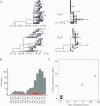SARS-CoV-2 Genomic Surveillance Reveals Little Spread From a Large University Campus to the Surrounding Community
- PMID: 34805437
- PMCID: PMC8600169
- DOI: 10.1093/ofid/ofab518
SARS-CoV-2 Genomic Surveillance Reveals Little Spread From a Large University Campus to the Surrounding Community
Abstract
Background: Coronavirus disease 2019 (COVID-19) has had high incidence rates at institutions of higher education (IHE) in the United States, but the transmission dynamics in these settings are poorly understood. It remains unclear to what extent IHE-associated outbreaks have contributed to transmission in nearby communities.
Methods: We implemented high-density prospective genomic surveillance to investigate these dynamics at the University of Michigan and the surrounding community during the Fall 2020 semester (August 16-November 24). We sequenced complete severe acute respiratory syndrome coronavirus 2 (SARS-CoV-2) genomes from 1659 individuals, including 468 students, representing 20% of cases in students and 25% of total cases in Washtenaw County over the study interval.
Results: Phylogenetic analysis identified >200 introductions into the student population, most of which were not related to other student cases. There were 2 prolonged student transmission clusters, of 115 and 73 individuals, that spanned multiple on-campus residences. Remarkably, <5% of nonstudent genomes were descended from student clusters, and viral descendants of student cases were rare during a subsequent wave of infections in the community.
Conclusions: The largest outbreaks among students at the University of Michigan did not significantly contribute to the rise in community cases in Fall 2020. These results provide valuable insights into SARS-CoV-2 transmission dynamics at the regional level.
Keywords: SARS-CoV-2; genomic epidemiology; infection prevention; transmission; university.
© The Author(s) 2021. Published by Oxford University Press on behalf of Infectious Diseases Society of America.
Figures




References
-
- Andersen MS, Bento AI, Basu A, et al. College openings, mobility, and the incidence of COVID-19. medRxiv 2020.09.22.20196048 [Preprint]. 23 February 2021. Available at: 10.1101/2020.09.22.20196048. Accessed 10 August 2021. - DOI
-
- Currie DW, Moreno GK, Delahoy MJ, et al. Description of a University COVID-19 outbreak and interventions to disrupt transmission, Wisconsin, August - October 2020. medRxiv 2021.05.07.21256834 [Preprint]. 10 May 2021. Available at: 10.1101/2021.05.07.21256834. Accessed 10 August 2021. - DOI
Grants and funding
LinkOut - more resources
Full Text Sources
Miscellaneous

